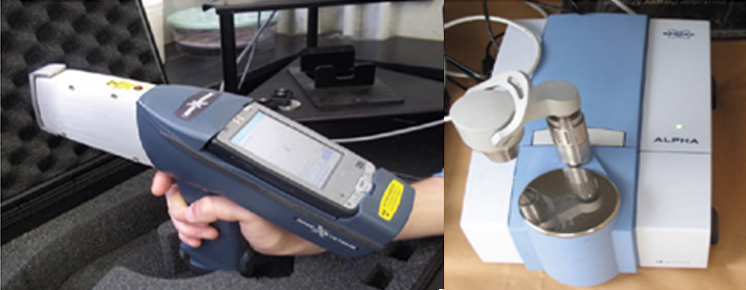
Materials verification without sampling delays
Techniques to Fingerprint Construction Materials (R06B)
Challenge
Quality assurance operations during construction are important aspects for ensuring that all contract requirements are met and that projects are built to last. However, verifying that construction materials meet project specifications can be a labor intensive and expensive operation, with test results often delayed and some materials only receiving minimal testing. This could potentially impact product quality and long-term performance. Field methods to quickly analyze construction materials such as paints, additives to asphalt, and reclaimed asphalt pavement (RAP) are beneficial to enhancing quality assurance.
Solution
SHRP2 Solution Techniques to Fingerprint Construction Materials evaluated portable spectroscopy technologies that can be used during construction to verify the chemical compounds or presence of certain additives or contaminants in some commonly used construction materials. SHRP2 evaluated an array of spectroscopy technologies in their ability for in situ analysis of commonly used construction materials in the field. Two technologies that show promise are the hand-held X-Ray Florescence (XRF) instrument and the compact Fourier Transform Infrared Spectroscopy (FTIR) unit. The SHRP2 Solution provides a rapid method for inspectors to use XRF to test pavement markings and epoxy coatings real-time in the field by determining their metal contents. The Solution also provides a method for using FTIR, working in the attenuated total reflectance (ATR) mode, to assess the degree of oxidation in RAP, as well as a method for fingerprinting chemical admixtures in freshly mixed Portland concrete cement.
The methods described above include generic testing procedures with sampling and data analysis guidelines, as well as proposed standards of practice that can be considered by the American Association of State Highway and Transportation Officials (AASHTO).
The SHRP2 Solution also provides a summary of portable spectroscopy technologies and their potential for identifying and quantifying additives and contaminants in common construction materials, such as using the FTIR for the identification of Polymer-additives in asphalt.
Benefits
State and local transportation departments, contractors, materials suppliers, and the public will benefit from these portable field spectroscopy technologies. Using these technologies on select construction materials, inspectors will be able to compare the materials’ signature in the field to those on file, providing cost- and time-saving advantages. The ability to confirm that the materials being used on-site meets contract specifications minimizes the risk for noncompliance. Field verification will also allow contractors to proceed quickly to the next project operation without having to wait for laboratory analysis results.
-

Save Lives
Minimizes the likelihood of failure due to poor quality materials, thus ensuring long-term material performance and reducing future safety impacts to the driving public.
-

Save Money
Avoids costly transportation and laboratory testing of common construction materials.
-

Save Time
Eliminates the time-consuming process of transporting samples to a laboratory for testing to verify the materials meet contract specifications.


